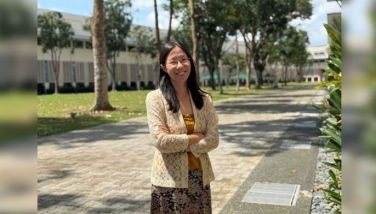2011 reform budget, P-noy style

When the Department of Budget and Management starts talking about “good governance in fiscal affairs,” expect a ton of concepts about how this would actually translate exactly how government will spend for its needs next year.
Under the leadership of Florencio “Butch” Abad, the DBM is currently pushing for the approval by Congress of the 2011 “Reform Budget” amounting to P1.645 trillion, which is 8.65 percent higher than the appropriation for this year.
“Reform budgets” are so much in vogue these days especially among governments hit by the recent global financial crisis. For example, in the U.S., reforming the budget has largely been focused on curbing health care costs, of which an average American already receives about $8,000 annually.
For the Philippines, however, reforming the budget structure is consistent with delivering what President Benigno Aquino III promised during his campaign, which includes prudent use of government funds to benefit those that need help most.
Four pillars
Thus, the 2011 budget, according to Abad, will be stand on four pillars. The first, transparency and accountability, is geared towards making government productive. As such, only big ticket items that are included in the master plan of the appropriate government agencies will have appropriations.
This will impact on pork barrel allocations since members of Congress may use this only in line with government priority programs. This way, the money allocated for the pork barrel will be more focused and controlled.
Every government agency that handles people’s money will also need to post in their websites details regarding the release, obligation, disbursement and implementation details of programs and projects, including cost, status, suppliers, project beneficiaries, among others, and supported by documentary evidence.
Reduce debt
The second pillar involves integrating fiscal responsibility and prudence in the 2011 reform budget with the aim of reducing debt. The automatic appropriations in the budget, which refers to interest payments and internal revenue allotments totaling P711.52 billion, for example will no longer be subjected to floor scrutiny.
This is in reaction to what happened in the 2010 budget, where Congress adjusted downwards the interest rate assumption. The “savings” of P64.6 billion on interest payments were then transferred to the general appropriations for Congressional initiatives.
New policies to support responsible and prudent expenditure were also put in place in the 2011 proposed budget. No new positions will be created except those that are population-related, such as teachers, uniformed and medical personnel. Allowances will be rationalized.
Increases in spending for utilities, communications and supplies will be limited. There will be no new building construction; the priority will be towards completing current construction projects. There will be no acquisition of new motor vehicles.
Zero-based budgeting
The DBM has likewise introduced zero-based budgeting (ZBB) approach in its review of the 2010 budget and in crafting the 2011 spending plan. According to Abad, this will help focus on the programs that matter, and eliminate irrelevant programs, inefficiencies and leakages.
Through zero-based budgeting, government was able to increase the funding for Conditional Cash Transfer (CCT) program almost three-fold to P21.194 billion by slashing the budgets for inefficient or ineffective programs such as agriculture input subsidies and the Kalayaan Barangay program.
Furthermore, the ZBB approach was used in reviewing the performance of government operated and controlled corporations (GOCCs) such as the National Food Authority (NFA). Thus, for 2011, the national government budgetary support to GOCCs decreased by P16 billion or a significant 65.9 percent.
This included the transfer of P8 billion for rice subsidies from NFA to the Department of Social Welfare and Development to ensure that poor households, as identified through the DSWD’s National Household Targeting System for Poverty Reduction, will directly benefit from the subsidy.
Bias for the poor
Lastly, the 2011 Reform Budget will be biased for the poor and the vulnerable. As such, priority projects of P-Noy for good governance, education, healthcare, and peace and security will have adequate funds.
The budget of the Department of Social Welfare and Development was increased by 122.7 percent to P34.3 billion, primarily due to the increased provision for CCT that will benefit 2.3 million poor households by the end of 2011.
Towards improving the life of the poor in the long-term, the education budget was increased by P32.3 billion to P207.3 billion. This will be essential in bridging the resource gaps that have prevented the delivery of quality education to poor students. More classrooms will be constructed, and 10,000 new teaching positions will be opened.
For healthcare, more subsidies for indigents and informal sector households are intended through the Philippine Health Insurance (PhilHealth). Provisions for immunization were tripled; also, some P7.1 billion was allocated for the upgrading of health and maternal care facilities to reverse the tragedy of 11 mothers dying daily due to complicated child births.
With all of these guidelines, let’s hope that Abad, who carries a master’s degree in public administration, together with his team will be able to guide and help the government in delivering at the very least the basic needs of the poorest sectors of Philippine society in the most cost effective manner.
NCAA-South 12th Season
Saturnino C. Belen, President of First Asia Institute of Technology and Humanities (FAITH), opens today the 12thseason of NCAA-South at the FAITH campus in Tanauan City, Batangas. The league is composed of 10 members: First Asia Institute of Technology and Humanities (FAITH), host for this year, Colegio de San Juan de Letran-Calamba, De La Salle-Lipa, Lyceum of the Philippines University-Batangas, University of Batangas, Philippine Christian University-Dasmarinas, San Pablo Colleges-SanPablo, University of Perpetual Help System-Laguna, Don Bosco Technical College-Mandaluyong and San Beda College-Alabang.
Despite the physical distance from each other (one is in Mandaluyong, others are in Batangas and Laguna), the members of NCAA-South have managed to nurture camaraderie and strengthen their unity for more than a decade through various sports activities like basketball.
The NCAA-South is one of the accredited “mother leagues” participating in the Champions League (PCCL) search for the best collegiate basketball teams in the country. The NCAA-South champion will advance to the Luzon-Metro Manila zonal qualifying games, and compete for a seat in the Sweet 16 Finals. Last year, Don Bosco represented the league in the Zonals.
Visit www.CollegiateChampionsLeague.net for more details about the 2010 Philippine Collegiate Championship games.
Should you wish to share any insights, write me at Link Edge, 25th Floor, 139 Corporate Center, Valero Street, Salcedo Village, 1227 Makati City. Or e-mail me at reydgamboa@yahoo.com. For a compilation of previous articles, visit www.BizlinksPhilippines.net.
- Latest
- Trending





























